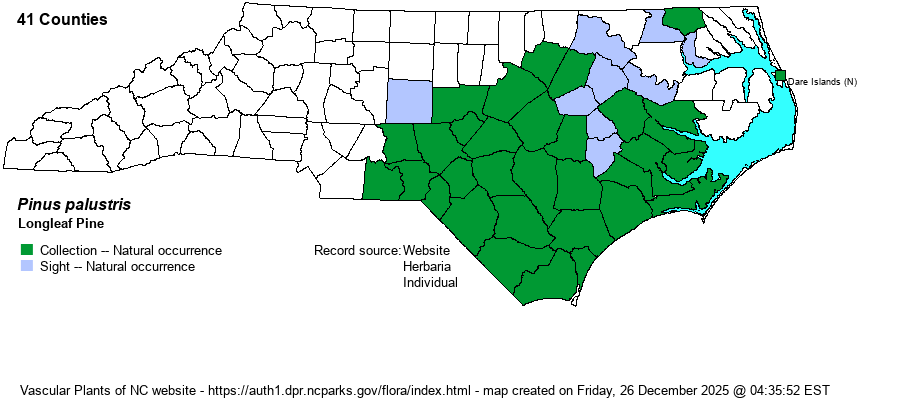| Author | P. Miller | |
| Distribution | Present over nearly all of the Coastal Plain, but scarce to absent in a handful of northeastern counties. The Dare County records are from extant populations on Roanoke Island and at Colington on the Outer Banks. Ranges into the eastern Piedmont, as far west as Randolph, Montgomery, and Anson counties.
A Southern species, ranging north to southeastern VA, and south to southcentral FL and eastern TX.
| |
| Abundance | Common to very common in the Sandhills region, as well as locally common to very common in southeastern counties from Craven and Carteret to the SC line. Rare to uncommon and local north to Gates County, and in the eastern Piedmont. Has strongly declined in the past 80 years owing to land conversion and to fire suppression, where Loblolly Pine (P. taeda) is replacing Longleaf Pine. Longleaf's great importance as a timber tree and as a source of sap and naval stores is well documented in many a book and article. | |
| Habitat | It is found mainly in sandy soil, which can be dry or moist. Typically it is found in dry sands of Carolina bay rims, coastal fringe sandhills, and sandy areas in the Sandhills region. It also is numerous in moist areas such as flatwoods and savannas and streamhead ecotones. In the Piedmont, it can occur on fairly steep slopes, as long as they are xeric and somewhat sandy or gravelly. |
| Phenology | Pollen is released in March and April, and cones mature in September and October. | |
| Identification | This is one of the most beautiful and familiar trees in the Southeast, being highly prized in yards for its stately appearance, as well as for its needles for pine-straw mulching properties. It is a large tree, growing to 100-110 feet tall, rarely taller. As the name implies, it has the longest needles of any of our pines, being found in fascicles of three and averaging 9-12 inches long; they are a bright to dark green in color (i.e., less gray-green or yellow-green than some other species). The mature cones are also much larger than on any other native pine, being 7-8 inches long, on average. (They are often collected for home decoration purposes.) This species can easily be confused with Slash Pine (P. elliottii), which is not native in NC (though its range extends to within 50 miles of NC) but which has been planted in plantations in some of our southeastern counties. Thus, observers need to know how to separate these two, as well as Loblolly Pine, which is ubiquitous in the Coastal Plain. Slash Pine needles are somewhat shorter – averaging about 8 inches long, and are grouped in twos and threes; they are a shiny bright green color. The cones are smaller, about 4 inches long, and have glossy red-brown scales, as opposed to dull and medium brown scales on Longleaf cones. Loblolly Pine has slightly shorter needles than Slash, always in fascicles of three and averaging 6-7 inches long; they tend to be duller – a gray-green or yellow green. The Loblolly cones have non-shiny scales that are plain brown, like a much smaller and narrower Longleaf Pine cone. | |
| Taxonomic Comments | None
| |
| Other Common Name(s) | None really, but Florida Pine, Georgia Pine, and Southern Pine are occasionally used | |
| State Rank | S5 | |
| Global Rank | G5 | |
| State Status | | |
| US Status | | |
| USACE-agcp | FACU link |
| USACE-emp | FAC link |

